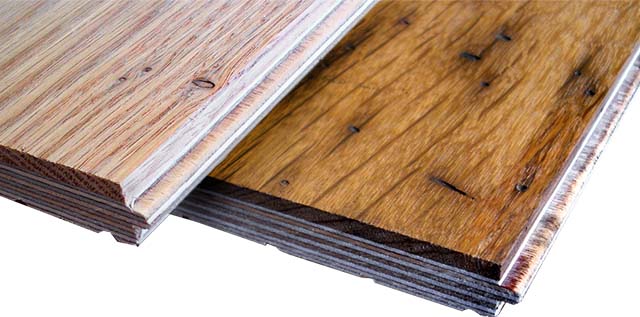
The Buying Guide for Engineered Flooring
Engineered flooring is becoming more and more popular as it can offer customers the same value and durability as solid hardwood flooring, but with more versatility. We say, "it can offer the same value and durability", not, "it does offer the same value and durability" because engineered flooring can be manufactured very differently. Just like in any big purchase, there are several factors you should research before you buy to ensure you get a product meant to last.
1. Wear layer
First, let us explain what a wear layer is. Engineered hardwood flooring consists of two parts: a top veneer (or wear layer) of solid hardwood flooring adhered to a plywood base/core.
Engineered hardwood flooring with a thick wear layer resembles solid hardwood flooring the most in terms of value and quality. Solid hardwood flooring typically has a wear layer of 6-7mm, with light maintenance, and can easily last 100 years. Our engineered hardwood flooring has a wear layer of 4mm - one of the most durable in the industry - and enables us to include more natural elements such as knots, natural
In comparison, you'll find that most mass-produced engineered flooring is sold with a thin, 1-2mm wear layer - making it more susceptible to damage and giving it a much shorter life expectancy. In short, the investment you gain by purchasing a quality-made hardwood floor far outweighs the short-term cost you save by using a lesser-quality product.
2. Thickness and Value to the "Core"
The plywood core in engineered flooring is what gives it the versatility not found in solid hardwood flooring. It is very important to consider the number of plywood layers because the more layers, the more stability, durability, and value. It is also important to consider the type of plywood that is used, as some plywood types are much better than others.
Our engineered flooring has an eight layer, Baltic Birch plywood core, specially designed, with the layers alternating direction for added stability. Baltic Birch is the preferred plywood because it consists of crossbanded layers, which makes it balanced. Some engineered flooring is manufactured with a plywood core consisting of as little as three layers. Ours, at 8-layers, is one of the thickest plywood cores available made from the best material in the industry.
3. More Options in Board Widths, Lengths, and Species
When purchasing engineered hardwood floors, research the plank widths and lengths. In fact, when purchasing any hardwood flooring, researching this factor is necessary. Wider widths and longer lengths means you are getting a full, high-quality product, not just remaining pieces. We offer widths from 3" to 12" and lengths of 2' to 12' - extremely uncommon with mass-produced engineered offerings.
In addition, it can be difficult to find some species manufactured as engineered flooring. Reclaimed engineered flooring, in particular, is difficult to find. Most of our products from our Traditional Plank line, Mustang Collection, and Reclaimed Antique line can be ordered as engineered flooring. We are one of the few manufacturers of wide plank flooring who can offer it in an engineered product - a fact of which we are very proud.
These three factors need to be researched when purchasing hardwood flooring, but as always, this is just the start and there are other elements to consider. If you're interested in hearing all of what you need to know, create a comment below or give us a call at 866-208-WOOD(9663).